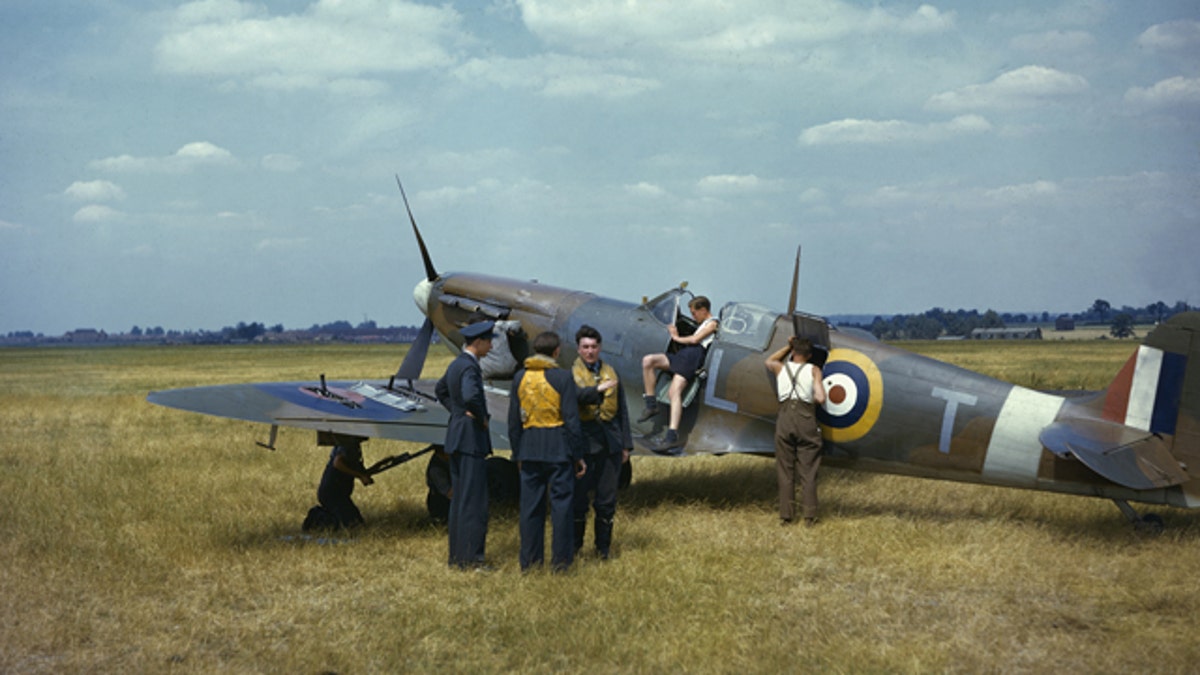
The Spitfire airplane -- designed as a short-range, high-performance interceptor aircraft -- is seen here during the Battle of Britain in a WWII-era photo. (William Vandivert/Time & Life Pictures/Getty Images)
After a 15-year treasure hunt, a farmer and aviation enthusiast struck gold, uncovering as many as 20 World War II-era Spitfire planes buried in Burma at the end of World War II -- a find he may lose to the British Donald Trump.
In April FoxNews.com reported the discovery of the priceless booty, a squadron of the legendary planes perfectly preserved in the chests they were shipped halfway around the world in. They were waxed, wrapped in greased paper and tarred to protect against the elements. They were then buried in their shipping crates, rather than let them fall into enemy hands.
The long-lost planes were discovered after a $200,000 quest by aviation enthusiast David Cundall.
British prime minister David Cameron sent a business delegation to Burma after the planes in late April -- and he brought along wealthy real estate developer Steven Boultbee Brooks instead of him.
"Mr. Brooks wants all rights handed over to him, including media rights, and if there's any money [left] over he says he might pay me something. It's appalling," Cundall told the Independent.
The 62-year-old Cundall claims he was pressured into abandoning his claim to the 67-year-old fighters by Brooks, a British version of Donald Trump who presented him with a "memorandum of understanding" that took control of his overseas activities, the Vancouver Sun said.
He learned of the Cameron / Brooks trip after the fact -- and called the terms of the memorandum an insult.
"I can do it without Brooks, I can do it without anybody. I've been digging up aircraft for 35 years. I've pushed the boat out financially. I've struggled like hell to keep it going. I've dug up Burma before, and I don't need them," Cundall told the Vancouver Sun.
Like Trump, Boultbee Brooks has a string of self-named businesses. He set up the eponymous Boultbee real estate firm in 1987 with his brother Clive; the firm reportedly now owns and manages an investment portfolio worth over $800 million.
He’s also an aviation enthusiast: There are an estimated 35 Spitfire planes still flying -- and Boultbee Flight Academy can teach you how to fly them on his Vicker’s Supermarine Spitfire, a training version of the plane built just after the war.
Cundall told the Independent that Burmese President Thein Sein promised the government in Rangoon would abide by its commitment to work with him, despite Brooks’ entry in the race.
"We were issued a permit to dig, which is still a valid and exclusive agreement," he said.
"The President of Burma wants to do business with me. He doesn't trust Cameron because when he visited they talked for two hours -- 10 minutes on removing sanctions and one hour and 50 minutes about the Spitfires," Cundall said.
Boultbee Brooks confirmed to SkyNews that he was working on the salvage operation.
"We're delighted to be working with the Myanmar and British Governments regarding the excavation of these Spitfires and their eventual repatriation to the UK,” SkyNews reported.
A spokeswoman for Brooks told FoxNews.com he could not be reached at present.
“At the moment the team is entirely focused on the project and is not giving any interviews,” said Elizabeth Tagge.
British farmer CUndall realized the fate of the aircraft thanks to an offhand comment a group of American veterans made to a friend, he told the Sydney Morning Herald.
''They told Jim: 'We've done some pretty silly things in our time, but the silliest was burying Spitfires.' And when Jim got back from the U.S., he told me,'" Cundall said.
He confirmed the location of the planes during a recent trip to the Far East country, he said.
''We sent a borehole down and used a camera to look at the crates. They seemed to be in good condition," Cundall told the Herald.
The Spitfire Mark XIV planes he discovered -- definitely a dozen and as many as 20 -- are rare for more than one reason: They used Rolls Royce Griffon engines rather than the Merlins used in earlier models to achieve tremendous speeds. Griffon-powered planes could reach 440 mph thanks to the hefty, 2,050-horsepower engines.
When production of the planes ultimately ended in 1947, 20,334 Spitfires of all versions had been produced, but just 2,053 of them were Griffon-powered versions, according to Encyclopaedia Britannica.
The planes were deemed surplus and were buried in Aug. 1945. At that time, propeller planes were falling out of fashion in favor of newer jet-engine designs -- Cundall said Spitfires "were 10 a penny." British military officials decided burying them was cheaper and more practical than bringing them home.
The challenge: Time is running out. The monsoon season begins in June, making the ground so water-logged as to be unworkable.
Boultbee Brooks told the Vancouver Sun he believes he can get there in time.
"We train pilots to fly Spitfires, we train engineers to build them, so yes, we would love to. We will keep this project on the road."




















